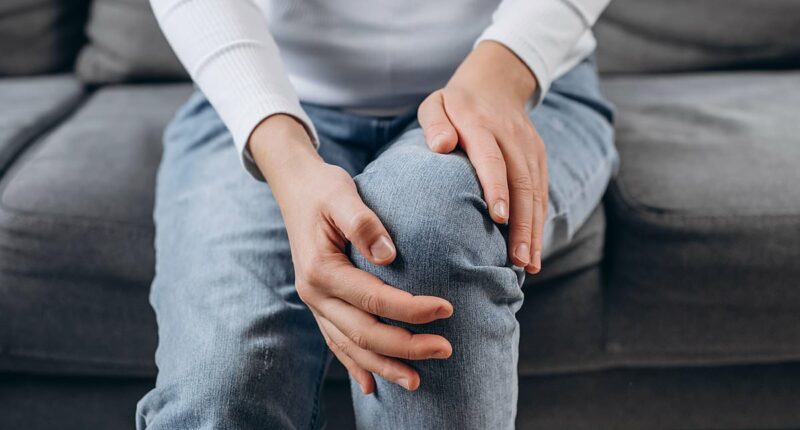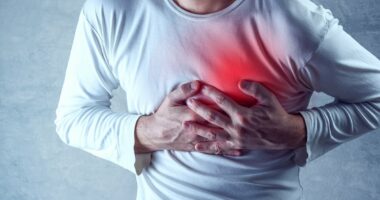Share this @internewscast.com
In the UK, chronic pain is a prevalent issue, impacting close to half the adult population, which translates to an astonishing 28 million individuals.
Common grievances include back pain, headaches, and inflammatory joint conditions such as arthritis. To alleviate these discomforts, both NHS and private practitioners frequently prescribe painkillers, aiming to help patients manage their daily lives.
Yet, according to Dr. Lafina Diamandis, a general practitioner who spoke with The Times, medication isn’t always the optimal answer, and sometimes it’s not the answer at all.
Dr. Diamandis explained, “Painkillers can be crucial in diminishing how pain signals are perceived by the body and brain.”
“However,” she cautioned, “it’s generally advised to use them for the shortest duration and at the lowest effective dose to minimize potential side effects.”
She further remarked, “Painkillers seldom tackle the underlying cause by themselves.”
Painkiller side effects can vary according to what drug you are taking, with the most common falling into one of three categories; paracetamol, non-steroidal anti-inflammatory drugs (NSAID) and opiates.
Dr Diamandis warned long-term use of NSAIDs can cause stomach ulcers, opiates run the risk of addiction, and paracetamol can cause ‘rebound’ symptoms.

It can feel like there is no hope in sight when you are suffering from chronic pain, but recent studies suggest simple lifestyle habits could provide some relief
But the route to a pain free—or more painless life—can be found outside of a blister pack of pills.
‘We now know that a holistic approach is essential for pain management,’ said Dr Diamandis.
‘A combination of therapies, rather than one single treatment is important to address the lifestyle, physical and emotional aspects of pain relief.’
With that in mind, these are Dr Diamandis’ eight holistic recommendations for combatting chronic pain, without pills.
Move your body
For years, patients were told that bed rest was the best remedy. But this approach has long been debunked.
Dr Diamandis’ prescription is to get the body moving, even if it’s just by doing gentle exercises.
‘For some people a gentle walk is ideal, others find that Tai Chi, yoga or other activities are helpful for pain relief,’ she said.
You should actually ‘rest in bed as little as possible’, according to John Hopkins Medicine because ‘too much bed rest weakens your muscles and could slow your recovery’.
However, the advice does warn people to take it easy.
It advised: ‘You should pay attention to pain and twinges, and stop to rest if needed, as ‘your body may be trying to prevent you from harming your back.’
Try acupuncture

Studies have shown that acupuncture can be an effective treatment for chronic pain
The traditional Chinese medicine practice sees needles inserted into specific parts of the body.
It is thought to provide natural pain relief by stimulating nerves under the skin and in the muscles that release ‘feel-good’ hormones called endorphins.
Previous studies have found that acupuncture can be an effective treatment for all sorts of pain conditions.
Sometimes it’s available on the NHS, who recommend a full course of five to eight sessions to feel a difference.
Reduce caffeine
If you rely on your morning cup of coffee to get you going, the good news is, you don’t have to give it up.
However, Dr Diamandis says chronic pain sufferers should restrict their coffee habit to three or four cups a day.
‘Caffeine increases the release of stress hormones and if you consume a lot of it your body will be permanently in a low-grade state of stress.
‘This has the effect of amplifying pain signals and switching off parts of the brain that reduce pain through positive emotions.’
It can also disrupt your sleep, which she said, ‘adversely impacts the nervous system repair cycle and increases pain-inducing inflammatory chemicals’.
Spend time in nature

Other research has shown walking in nature can help reduce stress caused by chronic pain
It can also help to get outside in nature according to a recent study by the University of Plymouth.
Getting outside in large green spaces like forests and parks can help distract the mind from pain, said lead researcher Alexander Smith.
His study found the time spent in nature helped relieve the stress and anxiety caused by chronic lower back pain.
‘Even five minutes in greenery can make a difference. A gentle walk in the park or by a river has unlimited benefits,’ he said.
‘It can rewire your brain in a positive way.’
Eating fatty fish
Unhealthy fats in processed foods are understandably not good for us as they cause inflammation that worsens pain, Rhiannon Lambert, a nutritionist told The Times.
But healthy fats such as those in oily fish can provide relief, says Rhiannon Lambert a nutritionist told The Times.
‘Healthy fats from foods like oily fish, nuts, seeds and olive oil provide omega-3 and monounsaturated fats, which help regulate inflammation and pain issues,’ she said.
Previously a Spanish study found oily fish consumption lowered the incidence of pain over five years.
But in another, American researchers found that eating too much omega-6 fats from processed snacks, cakes and fatty, cured meats may exacerbate pain.
It’s advised to try and load up your diet with healthy fats from whole, unprocessed foods like mackerel, salmon and avocados.
Try CBT or mindfulness techniques

A study has shown that cognitive behavioural therapy and mindfulness can provide pain relief
It may not end chronic pain entirely, but underlying emotional issues can make suffering worse, explained Dr Diamandis.
‘Some mindfulness approaches help to break the loops of pain that become self-perpetuating,’ she said.
‘They can effectively help to rewire your brain so that you deal with pain more effectively.’
Cognitive behavioural therapy (CBT) is a type of talking therapy that helps change how you think and act.
Meanwhile, mindfulness works by bringing your focus to the present moment away from other thoughts.
A recent trial found that CBT and mindfulness sessions both led to ‘meaningful improvements’ in pain tolerance for participants with chronic lower back pain.
Lead author of the study, Eric Garland, a Professor of Psychology said: ‘These therapies aren’t a total cure.
‘But they teach people how to develop the inner resources they need to cope with chronic pain and to live a better life.’
Add peppermint, turmeric, ginger and green tea to your diet

Interestingly a trial last year found peppermint, turmeric, ginger and green tea have pain-busting properties.
The findings were published last year by Australian researchers in the journal Frontiers in Nutrition.
‘Benefits may be due to the bioactive compounds in these foods which have anti-inflammatory and analgesic [pain relieving] properties,’ wrote the authors.
But the nutritionist, Ms Lambert told the Times: ‘They need to be part of a healthy, anti-inflammatory and mostly plant-based diet.
‘One that includes plenty of wholegrains, vegetables and fruit.’
Have a regular sauna
The final way to alleviate chronic pain is to relax in a dry heat sauna, according to experts.
‘The dry heat from a sauna actually decreases inflammation,’ Professor Kunutsor a heart disease expert at the University of Leicester told The Times.
In his study, published last year he showed regular saunas can lower pain severity from musculoskeletal disorders – conditions affecting bones, joints and muscles.
In the journal Temperature he and his colleagues suggested it ‘may be linked to their anti-inflammatory, cytoprotective [damage shielding] and antioxidant properties’.
















